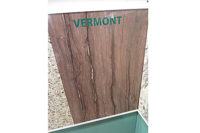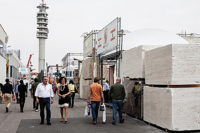
The 45th edition of Marmomacc was held in Verona,Italy, from September 29 to October 2, and it enjoyed significant increases in international exhibitors and visitors, as a total of 56,000 people were in attendance.
The 45th edition of Marmomacc - held in Verona, Italy, from September 29 to October 2 - enjoyed significant increases in international exhibitors and visitors, helping to consolidate the show’s position as the most important annual global event for the stone industry. Foreign exhibitors were up by 9 percent, to nearly 750 from 56 countries, or about 50 percent of the show’s total exhibitor base.
Newcomers included 10 Palestinian stone companies, which exhibited together at Marmomacc in a collective booth. Foreign stone trade professionals, representing 130 countries, increased by 13 percent relative to 2009. The number of total visitors also increased to 56,000 (+6 percent over 2009).
“The event confirmed its role as an economic and commercial platform at the service of companies in the sector,” said Ettore Riello, President of VeronaFiere. “These results help bring back some trust - after two very difficult years - to one of the historic and most specialized sectors of the ‘Made in Italy’ [brand].”
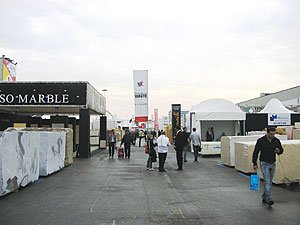
As usual, Marmomacc served as a forum for many stone suppliers to unveil materials to the international marketplace for the very first time. Visitors to the event saw new varieties of granite, marble, onyx and other materials that have never been seen before, and they also promoted classic materials that are being taken from newly opened quarry sites.
Additionally, a range of exotic materials were showcased at Marmomacc - and they came from locations around the world. These included semi-precious stones as well as backlit onyx panels.
Quartz surfacing also had an increased presence at Marmomacc, including new color varieties, textures, products with recycled content and even backlit onyx slabs.
In the area of stoneworking technology, exhibiting companies introduced several new innovations at Marmomacc. These included upgrades to equipment such as CNC stoneworking centers and computerized bridge sawing machinery. Many of the upgrades on display were specifically targeted towards shops specialized in countertop production, including developments in accessories such as vacuum pods.
For companies that supply stone treatments, Marmomacc allowed them to spread the message of their eco-friendly practices, which is of ever-increasing importance in today’s marketplace.
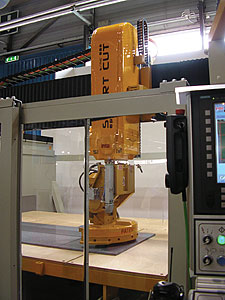
In the area of stoneworking technology, exhibiting
companies introduced several new innovations at Marmomacc. These included
upgrades to equipment such as CNC stoneworking centers and computerized bridge
sawing machinery.
Meetings and seminars
Marmomacc’s international flavor was also apparent at one of the many important events held during the four-day show. Over the years, Marmomacc has developed itself not only as a trade fair, but as an event with abundant opportunities for networking and education, and this year was no exception. A range of meetings and seminars were held over the course of the event, and they focused on some of the latest industry topics.The U.S.-based Natural Stone Council hosted a meeting of international stone trade associations - with representatives of India, China and many European countries in attendance - to discuss the group’s plan to launch an international certification program for sustainable stone materials. The program is expected to be operational in early 2012 and would apply to stone processed and imported into the U.S. (see “International Meeting on Sustainability held during Marmomacc” in this issue).
Additionally, the seminar, “Marketing Architectural Products in the U.S.: Continuing Education, Design Technologies and Social Networking” offered a look into electronic marketing platforms. Speakers for the event were Mark Johnson, FAIA, Director of Architect Relations & Education for Masco Cabinetry, and Dan Rea, Senior Vice President of the Commercial Division of Cold Spring Granite Co., and the session was moderated by Stone World Editor Michael Reis.
The speakers addressed the various new design technologies and electronic innovations being used by architectural product manufacturers. These included Google SketchUp and Building Information Modeling (BIM) software as well as social networking sites like Facebook and Twitter.

Equipment for block processing could also be found at
Marmomacc.
Rea’s presentation focused on his company’s use of technology to help architects specify various stone materials and products. “Cold Spring Granite Co. has an extensive Web site and people in the field promoting BIM and its capabilties,” Rea explained. “We got a $6.5 million project in Colorado due to BIM and Revit drawings.”
BIM typically uses three-dimensional, real-time, dynamic building modeling software to increase productivity in building design and construction. It is able to model representations of the actual parts and pieces being used to build a building, including architectural stone pieces. “We can actually create a building in digital before construction,” Rea said.
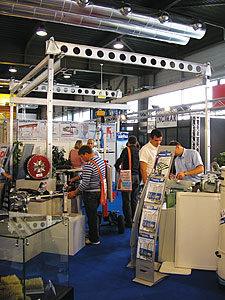
In addition to stoneworking machinery, a range of
tooling and accessories were exhibited on the show floor.
Weathering the storm
Show organizers stressed the continued importance of marketing to weather the economic downturn, with a particular eye on the American market. “The crisis is by no means over, but trends are turning around, especially for exports,” said Giovanni Mantovani, Director General of VeronaFiere. “China, Brazil, Russia, the Middle and Far East have started buying again. The keys to success in the sector, on the one hand, are the natural origin of stone products and, on the other, the capacity to offer made-to-measure solutions for the market. The U.S. market is still crucially important, and the edition of StonExpo/Marmomacc Americas next January is precisely geared to be at the service of Italian districts in the stone industry.”Organizers also released figures on the world stone industry. According to the statistics released, world production in 2009 came to about 215 million tons, which equaled 12.27 billion square feet (1.14 billion square meters) when computed at a nominal thickness of 2 cm. Per-capita stone consumption remained stable at 2,013 square feet (187 square meters) per 1,000 people, a slight increase over 2007 and a 38 percent rise over 2003. The top seven stone producers, in order, were China, India, Turkey, Italy, Iran, Brazil and Spain. These seven nations generated 75 percent of world quarrying output, two points higher than 2008 and six points higher than 2005.
In Italy, the stone sector employs about 60,000 people in 11,000 industrial and small-business companies, generating a turnover of U.S.$4.14 billion (3 billion Euros).
In the first half of 2010, overall Italian exports of raw and processed marble and granite reached a total value of U.S.$1.06 billion (771 million Euros), a rise of 6.0 percent over 2009. There was also a significant recovery in export of machinery and other technology, coming to U.S.$555.8 million (402.9 million) Euros during the first half of 2010, up 28.9 percent over the same period in to 2009.
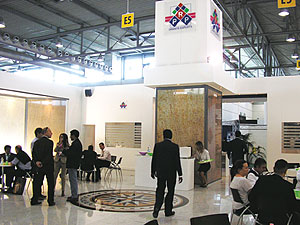
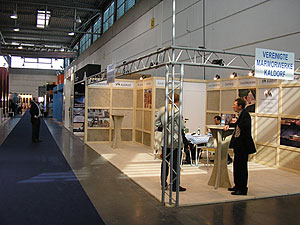
Foreign exhibitors were up by 9 percent, to nearly 750 from
56 countries, or about 50 percent of the show’s total exhibitor base.

As always, some groups of foreign exhibitions were
organized in national pavilions.
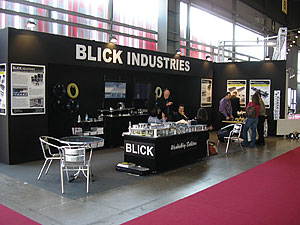
Among the international exhibitors, a handful of
American companies were exhibiting at Marmomacc.

Eco-friendly processes were emphasized by technology providers such as Tenax, which highlighted a number of practices at Marmomacc. Among them, the company promoted its water-based enhancers, oil-repellant treatments and waxes; its abatement of VOC (volatile organic compound) emissions; its use of natural extracts as the base for its mastics, epoxy resins, hardeners and abrasives; and the energy savings achieved through the use of its resin products, which cure at the same speed whether heated to 20 degrees C or 40 degrees C.
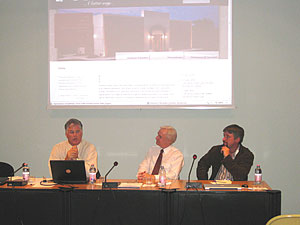
Among the seminars taking place at Marmomacc, the session “Marketing Architectural Products in the U.S.: Continuing Education, Design Technologies and Social Networking” offered a look into electronic marketing platforms. Speakers for the event were (from left) Dan Rea, Senior Vice President of the Commercial Division of Cold Spring Granite Co., Mark Johnson, FAIA, Director of Architect Relations & Education for Masco Cabinetry, and moderator Michael Reis, Editor of Stone World.
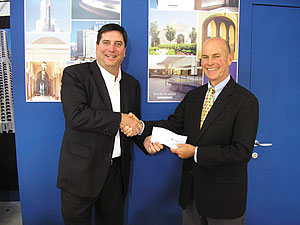
During the Marmomacc exhibition in Verona, Italy, Bob
Campo, Vice President of Quarry Sales for Rock of Ages, presented a $5,000
check to Gary Distelhorst, Executive Vice President of the Marble Institute of
America (MIA) for the Natural Stone Sustainability Fund.
Rock of Ages donates to MIA's Natural Stone Sustainability Fund in Verona
During the Marmomacc exhibition in Verona, Italy, Rock of Ages of Barre, VT, became one of the latest donors to the Marble Institute of America’s Natural Stone Sustainability Fund. Bob Campo, Vice President of Quarry Sales for Rock of Ages, presented a $5,000 check to Gary Distelhorst, Executive Vice President of the Marble Institute of America (MIA) on the show floor at Marmomacc.“Rock of Ages is happy to be able to support the MIA, and we have full confidence that the funds will be put to good use,” Campo said.
“We’re pleased to have one of the premier stone companies in the U.S. supporting our sustainability effort,” Distelhorst said. “Their funding and the contributions of others will support our continuous efforts to make natural stone the preferred sustainable building material.”

The 12th edition of Veronafiere’s continuing education
program for architects - co-sponsored by Stone World - took place during
Marmomacc and included a visit to the Ghirardi Botticino quarry.
12th edition of AIA continuing education program takes place at Marmomacc 2010
As part of its ongoing efforts to bridge the architecture and design community with architects and designers, Marmomacc once again held its AIA-approved course for architects. The program now includes courses in Italy, the U.S. and online.The 12th edition of Veronafiere’s continuing education program for architects had a distinctly international flavor with 33 architects representing the U.S., Canada, the U.K., India, South Africa, Singapore and Hungary. The architects spent four days “fully immersed” in stone design.
The participants toured the Ghirardi Botticino quarry and processing facilities near Brescia, learned how to install and care for dimensional stone from Mapei and Fila Chemicals, respectively, and one evening visited the Serego Alighieri winery in Valpolicella. Marmomacc’s continuing education program is co-sponsored by Stone World and recognized by the American Institute of Architects (AIA), the Royal Architectural Institute of Canada, the Royal Institute of British Architects, the Australian Institute of Architects, and the South African Institute of Architects.

Educational sessions took place in the field as well
as a classroom setting.

Representatives of Marmomacc/VeronaFiere welcomed 33
architects - representing the U.S.,
Canada, the U.K., India,
South Africa, Singapore and Hungary.
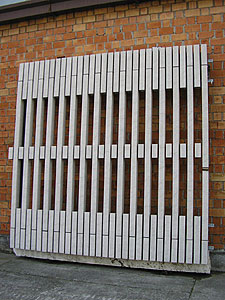
In addition to seeing the stoneworking machinery at
Ghirardi, the architects in the program also saw work in progress, such as this
mock-up that was done for renowned architect Mario Botta.
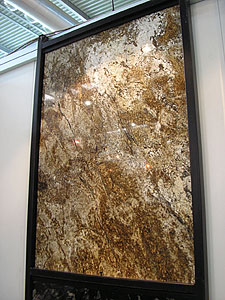
Bramagran: AJ Brown
www.bramagran.com.br
www.bramagran.com.br
A sampling of the stones in Verona
Once again, stone suppliers from Italy and around the world relied on the Marmomacc fair to showcase some of the latest stone materials to the international marketplace. The following is a look at just some of the stone materials on display in Verona.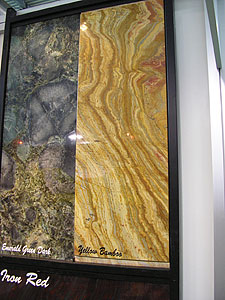
Brasigran: Yellow Bamboo
www.brasigran.com.br
www.brasigran.com.br

CaesarStone: Classico quartz
surfacing
with recycled content
www.caesarstoneus.com
www.caesarstoneus.com
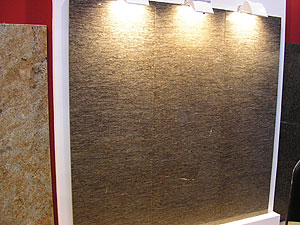
Madhucon Granites Ltd.:
Brown
Teak
www.madhucongranites.com
www.madhucongranites.com
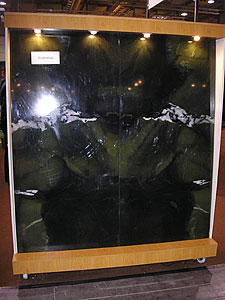
Mag-Ban: Avocatus
www.magban.com.br
www.magban.com.br

Magnitos: Copper Brown
www.magnitos.com.br
www.magnitos.com.br

Marcolini Marmi: Metal Silk Onyx
www.marcolini.it
www.marcolini.it

Pokarna Limited: Pokarna-Blacklit slabs of Quantra
quartz surfacing
www.pokarna.com
www.pokarna.com
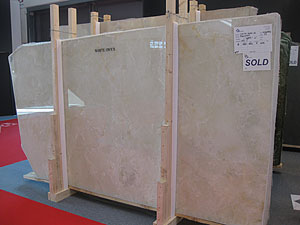
Primestone: White Onyx
www.primestone.ca
www.primestone.ca
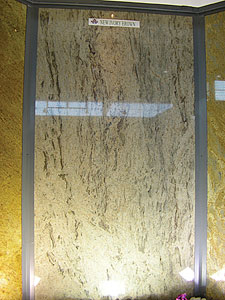
PRP Exports: New Ivory Brown
www.prpexports.com
www.prpexports.com
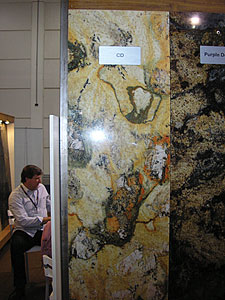
Santo Antonio: CD
www.santonio.com.br
www.santonio.com.br

Zucchi Granite: Revolution Red
www.granitozucchi.com.br
www.granitozucchi.com.br
